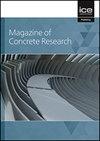Effects of desalinated sea sand on the alkali-silica reaction of seawater and sea sand concrete
IF 1.8
4区 工程技术
Q3 CONSTRUCTION & BUILDING TECHNOLOGY
引用次数: 0
Abstract
The application of seawater and sea sand concrete (SWSSC) can reduce the construction period and cost of island infrastructure, but it may also bring the risk of alkali-silica reaction (ASR) due to the presence of alkali ions in seawater and sea sand. To compare the characteristics of ASR between SWSSC and seawater and desalinated sea sand (DSS) concrete and investigate the effects of desalinated sea sand on the ASR of SWSSC, the properties and the ASR products of mortar-bars with different desalinated sea sand content were investigated. When the DSS proportion increased from 0% to 100%, the Na + , K + , and Ca + concentration contents and pH of the specimens decreased by 22.6, 2.0, 45.1 mg·L + and 0.05, and the expansion of mortar bars reduced by 0.16%. Desalination of sea sand could not eliminate the risk of ASR of SWSSC completely. The 14 days expansion of mortar bars with 100% DSS was 0.13%, and the precursors of ASR-P1 were observed by SEM. The experimental results of XRD, FTIR, Raman spectrometer, DTA, SEM, and EDX all showed that with the increase of DSS proportion, the content of Na-shlykovite and ASR-P1 were gradually reduced. A small amount of Mg element in both Na-shlykovite and ASR-P1 was detected by EDX, but the mechanism of Mg element in ASR of SWSSC needs further study. This study can provide a basis for the application of SWSSC in island infrastructure.脱盐海砂对海水和海砂混凝土碱-硅反应的影响
海水和海砂混凝土(SWSSC)的应用可以缩短海岛基础设施的建设周期和成本,但也可能由于海水和海砂中存在碱离子而带来碱-硅反应(ASR)的风险。为了比较SWSSC与海水和海水淡化海砂(DSS)混凝土的ASR特性,研究海水淡化海砂对SWSSC ASR的影响,研究了不同海水淡化海砂含量砂浆棒的性能和ASR产物。当DSS比例从0%增加到100%时,试件的Na +、K +、Ca +浓度含量和pH分别降低了22.6、2.0、45.1 mg·L +和0.05,砂浆条的膨胀率降低了0.16%。海砂淡化并不能完全消除SWSSC的ASR风险。100% DSS砂浆条14 d膨胀率为0.13%,扫描电镜观察到ASR-P1前体。XRD、FTIR、拉曼光谱仪、DTA、SEM、EDX等实验结果均表明,随着DSS比例的增加,Na-shlykovite和ASR-P1的含量逐渐降低。EDX在Na-shlykovite和ASR- p1中均检测到少量Mg元素,但Mg元素在SWSSC ASR中的作用机制有待进一步研究。本研究可为SWSSC在海岛基础设施中的应用提供依据。
本文章由计算机程序翻译,如有差异,请以英文原文为准。
求助全文
约1分钟内获得全文
求助全文
来源期刊

Magazine of Concrete Research
工程技术-材料科学:综合
CiteScore
4.60
自引率
11.10%
发文量
102
审稿时长
5 months
期刊介绍:
For concrete and other cementitious derivatives to be developed further, we need to understand the use of alternative hydraulically active materials used in combination with plain Portland Cement, sustainability and durability issues. Both fundamental and best practice issues need to be addressed.
Magazine of Concrete Research covers every aspect of concrete manufacture and behaviour from performance and evaluation of constituent materials to mix design, testing, durability, structural analysis and composite construction.
 求助内容:
求助内容: 应助结果提醒方式:
应助结果提醒方式:


